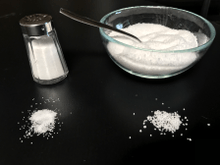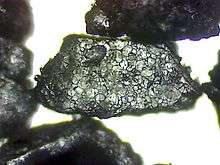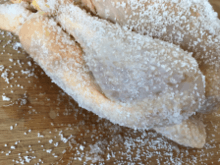Kosher salt
Kosher salt or koshering salt (outside the US called kitchen salt,[1] cooking salt, flake salt, rock salt or kashering salt) is coarse edible salt without common additives such as iodine.[2][3][4][5] Used in cooking and not at the table, it consists mainly of sodium chloride and may include anti-caking agents.

Etymology
Coarse edible salt is a kitchen staple, but its name varies widely in various cultures and countries. The term kosher salt gained common usage in North America and refers to its use in the Jewish religious practice of dry brining meats, known as kashering, and not to the salt itself being manufactured under any religious guidelines. Some brands further identify kosher-certified salt as being approved by a religious body.[6]

Usage
General cooking
Because the salt has a purer flavor due to the lack of metallic or bitter-tasting additives such as iodine, fluoride or dextrose, it is often used in the kitchen instead of additive-containing table salt.[7][8] Estimating the amount of salt when salting by hand can also be easier due to the larger grain size.[9] Some recipes specifically call for volume measurement of kosher/kitchen salt, which for some brands weighs less per measure due to its lower density and is therefore less salty than an equal volume measurement of table salt; recipes which call for a specified weight of salt are more consistent.[10] Different brands of salt vary dramatically in density; for one brand the same volume measure may contain twice as much salt (by mass) as for another brand.[11]
Brining / kashering meat

The coarse-grained salt is used to create a dry brine, which increases succulence and flavor and satisfies some religious requirements, sometimes with flavor additions such as herbs, spices or sugar.[12] The meat is typically soaked in cool water, drained, completely covered with a thin layer of salt, and then allowed to stand on a rack or board for an hour or more. The larger salt granules remain on the surface of the meat, for the most part undissolved, and absorb fluids from the meat, which are then partially reabsorbed with the salt and any added flavors, essentially brining the meat in its own juices. The salt rub is then rinsed off and discarded before cooking.[13][12]
Cleaning
Due to its grain size, the salt is also used as an abrasive cleaner for cookware such as cast iron skillets. Mixed with oil, it retains its abrasiveness but can be easily dissolved with water after cleaning, unlike cleansers based on pumice or calcium carbonate, which can leave a gritty residue if not thoroughly rinsed away.[14]
Manufacturing
Rather than cubic crystals, kosher salt has a flat plate-like shape and for some brands may also have a hollow pyramidal shape. Morton's salt is flat and Diamond Crystal is pyramidal. The flat form is usually made when cubic crystals are forced into this shape under pressure, usually between rollers. The pyramidal salt crystals are generally made by an evaporative process called the Alberger process. Kosher salt is usually manufactured with a grain size larger than table salt grains. According to Cook's Illustrated, Diamond Crystal salt is made by Cargill in St. Clair, MI and Morton Salt is from Chicago,IL.[15]
See also
- Pickling salt – Fine-grained salt used for manufacturing pickles
- Korean brining salt
- Pickling – Procedure of preserving food in brine or vinegar
- Curing (food preservation) – Food preservation and flavoring processes based on drawing moisture out of the food by osmosis
- Kosher foods – Foods conforming to Jewish dietary law
References
- "Kitchen salt definition". Collins. 2018.
- The Good housekeeping cookbook. New York: Hearst Books. 2001. pp. 15. ISBN 1588163989. OCLC 54962450.
- Bader, Myles. (1998). The wizard of food presents 10,001 food facts, chef's secrets & household hints : more usable food facts and household hints than any single book ever published. Las Vegas, Nev.: Northstar Pub. ISBN 0964674173. OCLC 40460309.
- Simmons, Marie (April 2008). Things cooks love (First ed.). Kansas City. pp. 67. ISBN 9780740769764. OCLC 167764416.
- Morgan, Diane, 1955- (2010). Gifts cooks love : recipes for giving. Kansas City: Andrews McMeel Pub. pp. 14. ISBN 9780740793509. OCLC 555648047.CS1 maint: multiple names: authors list (link)
- "Kosher Salt Guide". SaltWorks. 2010.
- Iodine Nutriture in the United States: Summary of a Conference, October 31, 1970. National Academies. October 31, 1970. pp. 36–. NAP:13984.
- World Health Organization (2011). Bulletin of the World Health Organization: Bulletin de L'Organisation Mondiale de la Santé. World Health Organization.
- Nosrat, Samin (April 25, 2017). "The Single Most Important Ingredient". The New York Times. Retrieved 2018-04-07.
- Kaiser, Emily (February 25, 2004). "Chefs Who Salt Early if Not Often". The New York Times. Retrieved 2018-04-08.
- "The Kosher Salt Question: What Box Does What? There's a Difference". TASTE. 2017-10-11. Retrieved 2019-07-18.
- Benwick, Bonnie S. (November 14, 2007). "Wet Brining vs. Dry: Give That Bird a Bath". The Washington Post. Retrieved 2018-04-07.
- Luban, Yaakov (2010). "Orthodox Union Kosher Primer". Orthodox Union.
- Lewis, Hunter (January 23, 2012). "How to Clean Your Cast-Iron Skillet". Bon Appetit. Retrieved 2018-04-08.
- "Kosher Salt" (PDF). Salt Institute.
| Wikimedia Commons has media related to Kosher salt. |